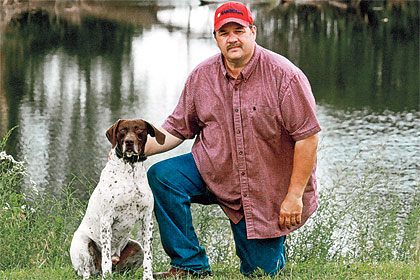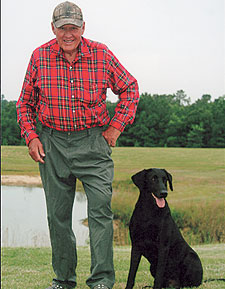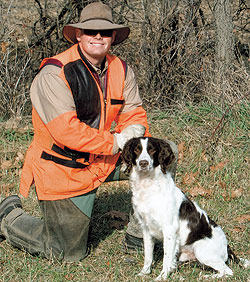The latest training techniques for pointing breeds, retrievers and spaniels.
By James B. Spencer
Pointing Breeds
"Releasing a young dog for his first wild bird hunt," Cap said, "will give you one of hunting's greatest pleasures. However, you should hunt him alone, not with other dogs, for at least his first several trips."
 Pointing Breeds: This tip is from Cap Anderson of Hunt 'Em Up Kennels, 1390 SE 40th, El Dorado, KS 67042; (316) 644-8161; website www.huntemupkennels.com: e-mail huntemupkennels@hughes.net. Cap has been training pointing breeds professionally for six years, specializing in training for hunting. He breeds German shorthairs. |
Cap feels that by hunting your youngster alone, you and he will be more able to set your own pace. More importantly, you can learn to read each other more precisely. Granting that a young dog can learn valuable lessons from an older, more experienced dog, Cap pointed out that he can also learn some less-than-valuable lessons. Ergo, you'll find it safer to hunt him alone for a while before exposing him to other dogs.
Cap recommends that you take another person, especially a family member or good friend, along in these early hunts, but only one person per outing. The two of you can take turns shooting. But you should shoot only once or twice per bird, and you should shoot only at birds your dog has pointed.
Cap stressed that you should never take a first-year dog out with a large group of hunters.
"Too many shooters, all shooting at one bird," he said, "can make a young dog gunshy, even if the youngster has been thoroughly gun-proofed in training. Some dogs become so terrified at so much shooting that they run back to the truck and refuse to go out. Others become 'huggers' that won't leave their owner's side."
If the one person you take along isn't familiar with your dog, Cap recommends that you let the two get acquainted before taking to the field. He even recommends that you let your friend play "fetch" with your dog as part of the introduction.
"When hunting," he said, "if your dog brings a bird back to your buddy, what difference does it make, as long as he brings it back to someone?"
When can you safely begin hunting your dog with other dogs? Cap recommends that you wait until after you've hunted your dog alone often enough to be able to read him and control him. Even then, you should hunt him with only one other dog, and that dog should be well-trained. Before the hunt, if possible, you should work the two together in a few training sessions. When hunting two dogs together, you and your buddy need absolute control over both dogs.
"Don't hunt your pointing dog with a flusher," Cap said, "unless you can keep them widely separated, like by a fence or hedgerow. If they get too close to one another, the flusher will flush birds that your dog has pointed. It doesn't take much of that to turn your pointing dog into a flusher."
Cap recommends that, when hunting your dog, you take along plenty of water for him.
You should also have a collar (e-collar if you've trained with it), a leash, a whistle, a first-aid kit, and a supply of treats.
"Don't overwork your dog," he said. "Hunt him for a couple of hours, even less if he shows signs of tiring or getting hot. Then give him drink and rest him awhile."
Cap's final thoughts: "Before taking your dog hunting, work him on all his control commands until he's really sharp. If you don't have time, have a pro tune him up for you."
 Retrievers: This tip is from John Dahl of Oak Hill Kennel, 625 Black Hawk Road, Vass, NC 28394; (910) 245-2603; website www.oakhillkennel.com; e-mail amy@oakhillkennel.com. John has been training retrievers professionally for 36 years, specializing in training for hunting and field trials. He breeds Labradors, goldens, and Chesapeakes. |
Retrievers
"During your retriever's first season," John said, "you should take one hunting buddy along. Let him do the shooting while you concentrate on your dog's work. During that first season, forget about filling your gamebag."
He stressed that your hunting buddy should be a good shot, should avoid sky-scrapers, and should be careful to keep the muzzle blast from his shotgun away from your dog's head. He said that, although retrievers don't become gunshy easily, it can happen with too much muzzle blast too close.
"Retrievers aren't completely gun-proofed in training," he said. "To make them so, we'd have to shoot all their training birds directly over their heads. If we did that, they'd develop a hearing problem!"
He added that, although gunshyness is rare in our stable-temperamented retrievers, it can happen with too much exposure to too much noise too soon.
"For example," he said, "five hunters suddenly firing 15 magnum rounds near a sleeping dog can provoke a fearful reaction."
John feels that during your retriever's first hunting season you should not hunt him with another dog. To hunt two dogs together requires extensive specialized training for both dogs. The typical first-year youngster simply hasn't had enough of that training. In fact, John prefers never to hunt more than one retriever at a time. He has found hunts with multiple retrievers more stressful, less enjoyable, and no more productive than hunts with just one.
"In a hunt, one retriever is an asset," he said. "Two is a liability. Three is a disaster. If I go hunting with a new pal, and he wants to bring his retriever along, I leave mine in the kennel."
John said that when hunting waterfowl from a blind, given our current bag limits, a retriever will almost never get so much work that he tires and needs a rest. Even if he has to plow through all sorts of tangles and tules for each retrieve, he usually gets plenty of rest between flocks.
"On dove shoots," he said, "when it's hot and still, if I can't find a shady place where my dog can stay safely cool, I leave him at home."
In the uplands, John stressed that you must be careful not to over-work your dog. In warm weather, you must also keep him from overheating, which can be life-threatening.
When he shows signs of tiring, you should give him a drink and put him up for a rest until he recovers. Overheating, being much more serious, requires immediate action. John listed the symptoms of over-heating as rapid panting, the tongue rolling out of the side of the dog's mouth, glazed eyes, and pale gums.
"If anything, be over-cautious and don't let these symptoms occur," he said, "but if they do occur, cool your dog as best you can and then run, don't walk, to the nearest veterinarian. Heat strokes can be fatal."
John recommends carrying the following dog-related equipment when hunting: a close-fitting collar, a short lead, water, an insulated vest (in severe conditions), your whistle, and perhaps a comfortable pad for your pooch to lie on in the blind. If your dog has been e-collar conditioned, you might also carry your e-collar.
"I don't normally use the e-collar while hunting," he said. "In fact, in snag-infested water, where a collar might hang up, I hunt my retrievers without any collar at all."
John's final thoughts were: "Be reasonable and don't expect miracles during your retriever's first hunting season. Since you cannot fully simulate hunting in training sessions, his first few hunts are critical learning opportunities. Your retriever is a novice needing help. Forgive his mistakes and encourage good habits. Remember: Dogs are only human!"
 Spaniels: This tip is from Morgan Haglin of Pine Shadows Kennel, 14752 Three Mile Road, Brainerd, MN 56401; website www.pineshadows.com; e-mail mark@pineshadows.com. Morgan has been training all spaniel breeds professionally for eight years, specializing in training for hunting and field trials. He participates in field trials for English springers. He breeds English springers. |
Spaniels
"During your young spaniel's first hunting season," Morgan said, "you can hunt him alone or with other dogs. It's your choice, and both ways have pluses and minuses -- just be aware that your dog can learn both good and bad habits from older dogs."
Morgan pointed out that an older dog can teach a youngster how to find birds. It takes experience for a dog to learn this skill, and for a youngster hunting alone, not finding any birds can be very discouraging.
By hunting with an older dog, your spaniel can learn from his bracemate's successes, instead of from his own trials and errors. An older dog can also teach the neophyte spaniel how to pace himself and can show him the difference between running in the field and running on the training grounds.
On the other hand, Morgan added, an older dog can teach a youngster to range out too far. He might also steal retrieves from the youngster.
"Nevertheless," he concluded, "I favor hunting a young spaniel with older, more experienced dogs."
He also said that when hunting with dogs belonging to others, you should focus entirely on your own dog's work and not worry about what the other dogs are doing. "For example, if your dog is supposed to be steady to wing and shot, make sure he doesn't backslide when hunting, regardless of what the other dogs do."
Morgan feels that you can comfortably take a couple of buddies along during your spaniel's first hunting season, provided they are aware of your dog's skills and will follow your instructions.
"Hunt with people you know and trust," he said. "Of course, they need to know quite a bit about how your dog works. For example, if your spaniel leaps up in the air after flushed birds, your buddies must realize that it's not safe for them to shoot below 10 o'clock."
Morgan feels that, if your puppy has been properly gun-proofed in training, a couple of additional shooters won't disturb him while hunting. However, he warned against really large hunting parties, all emptying their guns at the same at one or two flushed birds. This can really unnerve even the most thoroughly gun-proofed young spaniel.
To avoid over-working your spaniel, Morgan advises that you stop for a rest whenever you notice that your dog is slowing down a bit. Then, too, you should stop and give your dog a rest whenever you find yourself becoming tired. After all, your dog is covering many times as much ground as you are in every field.
"If it's warm out," he said, "you need plenty of water. If your dog starts panting heavily, you should stop, give him a drink, and let him rest in the shade until he snaps back again. And remember that it's hotter for him down in the cover than it is for you walking upright behind him."
He recommends carrying individually-wrapped caramels to give your dog for energy when he's hot or tired. He said that you should take along whatever equipment you carry while training: collar, lead, whistle, water bottle, and so forth.
"You should have a first-aid kit in your vehicle," he said. "Make sure you know how to use everything it contains. Otherwise, it won't do you much good when you need it. You should, above all, know a local vet's phone number."
Morgan's final thoughts were: "If your spaniel has been trained by a pro trainer, listen to him! Ask him questions and follow his advice. You might also seek out other experts, both pros and experienced amateurs. E-mail questions to them. Most of them will be happy to answer your questions even if they did not train your dog."






